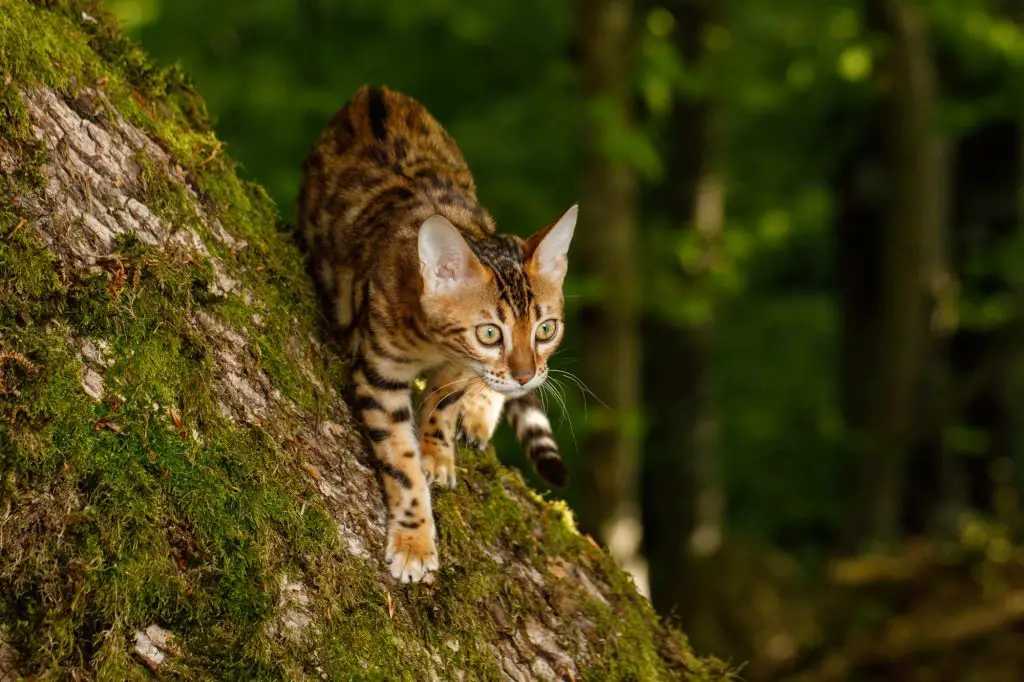1. Bengal Cats Are Part Wildcat
That’s right, Bengal cats actually have a wild ancestor, the Asian leopard cat, that are responsible for the beautiful coat they now wear today.

Nowadays obtaining an Asian leopard cat would be difficult as there are regulations on buying such an exotic animal from South and East Asia, but it wasn’t so difficult back in the 1980s when Jean Sugden Mill purchased one and cross bred it with a domestic cat to produce the first ever Bengal kittens.
But breeding the first few litters of Bengal cats was difficult for several reasons. First, most of the first few litters of Bengals were skittish and anxious like their wild Asian leopard counterpart. It would take time and selective breeding before Bengal cats adopted the loving and playful personality we’re familiar with today. Second, since they were a cross between two different species, the first male Bengals cats were infertile. After three generations, only about half of the males were fertile, which slowed down the breeding process considerably. Lastly, the Bengal cat received a lot of controversy in its first decade as a new breed. People argued that a cat descended from a wild ancestor could be dangerous and unfriendly, and had no place in a cat association. Although TICA accepted the Bengal into competition status in 1991, other associations were slow to follow, and stipulated conditions on accepting the breed. One such stipulation was that the show cats had to be five generations removed from their wild ancestors in order to compete.
Now cat lovers can have their own version of an Asian leopard by owning a Bengal cat, which has been modified by selective breeding ever since Mill created the first one back in the 1980s. Bengal cats now come in a variety of colors and patterns, and have an energetic and lovable personality.
2. Bengal Cats are One of the Most Popular Breeds
Up there with Maine Coons and Ragdolls, Bengal cats are one of the most popular breeds to own.
Bengal cats were on the top of TICA’s most registered cat breed list at 6,369 kittens. Ragdolls were number 2 at 4,050 registrations and Maine Coons were number three at 2,062 registrations.
3. Bengal Cats Have a Wide Variety of Patterns and Colors
Most people don’t know that Bengal cats can have a variety of beautiful coat patterns and colors. We usually think of the typical spotted brown Bengal when we try to imagine one, but they can also come in a marbled or spotted rosette pattern. Their colors can also range from silver (“grey”) and snow to charcoal and black.
Click here to see more of the Bengal cat’s possible patterns and colors.
4. Bengal Cat Hair “Glitters”
Bengal cat hairs have an appearance of glittering in the sunlight, which is caused by translucent hollow hair shafts that catch light and reflect it.
Any Bengal cat owner can attest to the lovely glow their Bengal has when they bask in the sunlight by the window.
5. Bengal Cats are Extremely Playful and Energetic
You haven’t seen a playful cat quite like the Bengal before. Perhaps they receive their voracious appetite for playtime from their wild leopard cat ancestors, but whatever the cause, they can’t get enough climbing, jumping, leaping, hunting and chasing.
Be sure to get your Bengal cat plenty of toys to play with and things to climb on, and don’t be surprised if you find them on top of the fridge or in places you never thought they could get to.
Also don’t expect the Bengal cat to slow down much in their adult years; if you’re looking for a more mellow and relaxed cat, perhaps the Bengal cat is not for you.
6. Bengal Cats Are Not Legal in All Places
Unlike other breeds, it’s not legal to purchase a Bengal cat in some places. Hawaii and New York City are two such places where the breed is outright banned, and some places such as Denver and Seattle have restrictions on which generations of Bengal cat are allowed.
The reason for such tight restrictions is due to the fact that many people still mistrust a breed that has a wild ancestor. Some places only restrict up to the first four generations of Bengal cats, which are genetically closer to their wild Asian leopard cat ancestor and deemed more unruly and dangerous.














